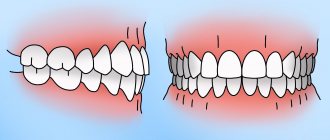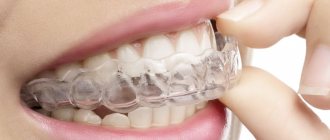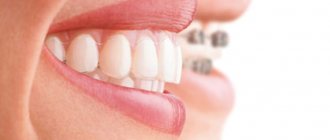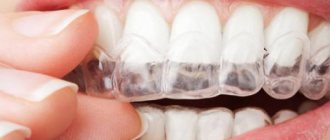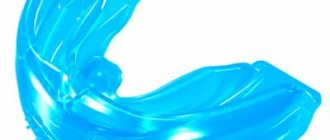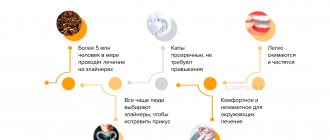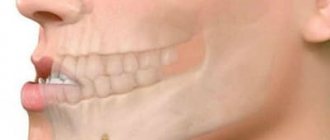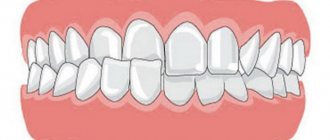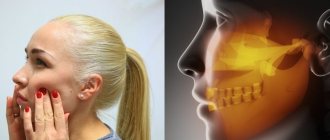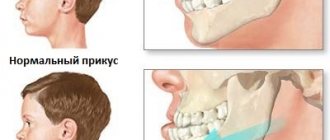Indications and contraindications Aligner technology Treatment regimen Advantages and disadvantages Care Reviews Specialists
Treatment of malocclusion in a child is corrected not only by installing braces. Transparent aligners can be used to straighten teeth in children.
This replacement for the bracket system appeared relatively recently - about 15 years ago they began to be used in orthodontics. The material chosen for them is transparent biosilicone or bioplastic, which obtains the properties of strength and elasticity.
The mechanical impact is insignificant - children's mouth guards gradually straighten the teeth without causing serious pain. The second name of the instrument is aligners, which in their principle and structure are similar to adult models. You need to wear mouthguards constantly - under normal conditions, about 22 hours a day, removing them while eating and brushing your teeth.
When are children's aligners needed?
You need to correct your child’s bite right away—in the first stages, all procedures are more effective and simpler. But usually parents come to the orthodontist after 12 years. A special feature of our clinic is that we treat occlusion without braces from the age of 7, that is, even the presence of baby teeth does not prevent us from planning treatment with aligners.
If you compare this bite mechanism and classic braces, then in the aligners you can see changes in the structure and position of the teeth in advance. The technique involves 3D scanning and already at the appointment you will be able to see the result - your future smile.
This can motivate the child well and add patience to him while wearing. After the appointment, the doctor will describe all the actual treatment methods, assessing the child’s personal characteristics.
Sign up for free 3D modeling of your future smile!
Make an appointment
*By making an appointment you consent to the processing of your data
Cases when wearing a mouth guard becomes necessary:
- you need to remove the gaps between the teeth;
- crowded teeth;
- incorrect alignment of the jaws;
- rotation of teeth in different directions;
- protruding jaw;
- The teeth in the row are positioned incorrectly.
A dental mouth guard for children can solve the same problems as braces. With one difference - they are more comfortable for the child.
general information
Children's dental mouth guard is made of soft medical silicone or polyurethane. They are chosen for the treatment of minor anomalies in the development of the dentition. Crowded teeth or large gaps between them require braces.
The difference between adult and children's mouthguards is insignificant: they are made the same, the material is the same, and the only difference is in size. To correct a bite, a set of mouth guards consisting of 12-25 mouth guards is most often required. Each design is numbered and its purpose is to correct uneven teeth, millimeter by millimeter, and to hold the teeth in a given direction. Each mouthguard is worn for 2 weeks. The daily duration of the device being in the mouth of a small patient ranges from 3 to 22 hours (depending on the indications). Once every 30 days, dentists advise seeking a consultation. This allows you to adjust the treatment and carry out timely sanitation of the oral cavity.
Indications and contraindications
Typically, a mouthguard for straightening teeth in children does not cause irritation and is not felt in the mouth. The transparent and flexible design fits tightly to the teeth, making it invisible to the eye. We have already named the main indications for use - they include dental pathologies of growth and its direction.
And although the doctor will warn you about possible obstacles, we will give you a list of contraindications.
Mouth guards for children are a modern, safe and effective method of treating children's malocclusion.
Benefits of correcting your bite with mouthguards
- Efficiency. The positive result of therapy is due to the computer calculation of the parameters of the aligners in strict accordance with the characteristics of the clinical case.
- Wearing comfort. The aligners do not injure the mucous membranes of the cheeks and lips, as they have the smoothest possible surface. They can be removed and put on independently, without the help of a doctor.
- High degree of aesthetics. The appearance of the products does not cause rejection among children.
- There is no fastening elements and no need to apply an adhesive mixture to the enamel surface.
- Hypoallergenic. The material for making correctional products does not cause allergic reactions in the child.
- Possibility of use with other orthodontic structures.
- Short adaptation period.
- Quick restoration of diction.
- Easy to care for your mouth and aligners.
- No need to adhere to a special diet.
Aligner technology for children: features
Dental mouth guards for a child are made to order after visiting a doctor. During the appointment, he examines the oral cavity, evaluates options for aligning and improving the bite.
How does a consultation take place at Propricus:
- The doctor examines the oral cavity, makes a diagnosis (determines the pathology of the bite)
- A photographic puncture is performed to determine how the bite affects the asymmetry of the face and head position. Often, malocclusion leads to changes in posture.
- The child undergoes a 3D scan. This is a safe option that takes no more than 15-20 minutes and allows you to display the current location of your teeth on the monitor in 3D format.
- The doctor develops a preliminary treatment plan online in the program and within 10 minutes, you and your child can see the future result of their smile, which can be achieved with the help of aligners.
- The doctor discusses with you the timing, features of treatment, cost of treatment, possible installment plans.
Invisalign children's dental guards are made from a patented hypoallergenic plastic. This is especially important when a child is allergic to the materials of the braces system or there is severe irritation of the oral mucosa.
Trainers for children
Trainers are mainly used at an early age - from 3 to 9 years, during the period of baby teeth and mixed dentition. They correct defects in the development of the dental system associated with various dysfunctions.
Often problems with bite are complex, for example associated with improper breathing. In particular, a small child may have enlarged adenoids, he cannot breathe fully through his nose and uses his mouth to do this. If this continues for a long time, then a number of problems arise.
- The upper jaw is formed incorrectly - it narrows in the lateral sections, as a result there is not enough space for the eruption of permanent teeth.
- Improper development of the upper jaw causes developmental defects in the lower jaw, and diction suffers from this.
- The muscles of the lips, tongue, and cheeks also do not work correctly, which negatively affects the aesthetics of the face: the neck is pulled forward, the lower third of the face lengthens, and the middle zone is poorly developed.
- The child cannot swallow fully, which affects digestion.
In this case, the orthodontist may recommend wearing trainers - they help the eruption of permanent teeth, develop the muscles of the oral cavity, help restore proper breathing, and shape posture. These mouthguards are worn during the day for several hours and throughout the night. The treatment process can be supplemented with developmental exercises.
General treatment regimen
After starting treatment, you receive a set of mouth guards, which must be changed every 7 - 14 days, as prescribed by your doctor. This can be done at home, which is a tangible advantage over braces - systems where the arch is changed only in the dentist's chair.
The aligners work due to the fact that each subsequent one is slightly different from the previous one and gradually moves the teeth into the position that we planned.
Before installation and starting the course, you need to cure caries and eliminate any inflammation on the gums.
Children's mouth guards have the advantage not only that they can be changed independently. The most problematic story of our little patients is hygiene. Children's aligners make brushing your teeth easy because they can be removed.
An orthodontic mouth guard does not cause any discomfort, and adaptation to the mouth guard occurs within a few minutes. This is the main difference from the braces system, which takes more than one day to get used to.
Manufacturing
During the preparation, the doctor cleans the little patient’s teeth with ultrasound and, if necessary, treats caries to eliminate sources of infection in the mouth. After this, an impression of the dentition is taken and an X-ray is taken.
In the manufacturer’s laboratory, using computer software, they create a virtual model of the aligners, program the movement of the teeth and the final result. Then a set of individual plates is made using this model. The whole process takes 1-2 weeks. During the fitting, the doctor tells the child and parents how to use and care for the mouth guards.
Advantages and disadvantages: what is better to know in advance?
We have already briefly described the comparison of aligners and braces for a child. For the bite and its formation, mouth guards will be a gentle tool. Positive features:
- simple removable device;
- no restrictions on food;
- no complications with hygiene procedures;
- the development of caries during wear is excluded;
- no damage to gums or enamel;
- quick addiction;
- preservation of the original appearance - transparent material is invisible.
Negative aspects may arise: you need to convince the child not to remove the children's mouth guards on their own in order to maintain the effect. Motivation from parents and doctors helps here. Among the disadvantages, we note that aligners are perceived as an expensive treatment option, although with a full calculation, you will be convinced that the final cost of a similar treatment with a brace system is comparable in cost.
Although these disadvantages seem insignificant if you focus on practicality and absence of pain. For children, these parameters seem to be the most important.
Treatment of children using FlexiLigner aligners at the “Smile” dentistry
Dentists at the branches of our center use only reliable and proven technologies and devices to treat children. FlexiLigner aligners are one of them. The cost of therapy is from 350 thousand rubles. Treatment with KidsLight aligners costs from 90 thousand. This amount includes the manufacture of mouth guards, monthly visits to the doctor and retention devices.
The dental network offers affordable prices for orthodontic services, payment in installments during the course of correction, and a family discount when servicing several family members.
Our specialists regularly improve their professional status by studying in leading clinics in Russia and Europe. This allows us to offer world-class dental services to our patients.
The clinic has two branches in different areas of Moscow. You can choose the one that is more convenient for visiting:
- branch near the Alekseevskaya metro station (VDNKh area and Mira Avenue) at the address: st. 3rd Mytishchinskaya 3, building 2;
- Shelepikha metro station, address: Shelepikhinskaya embankment, 34, building 1.
It is within your power to make your child’s smile cheerful and beautiful, and to eliminate in advance the problems that he may encounter in the future. Come to our orthodontic centers, we can help you!
What to do with care?
A mouthguard for straightening teeth in children does not require specific or atypical actions. All care consists of timely replacement and storage under normal conditions. Aligners should be removed before eating - many foods can stain them. Although you are allowed to drink water without harm.
After eating, you need to rinse your mouth with water to remove any leftover food, or even better, brush your teeth. Mouthguards can only be put on a clean surface. Cleaning the product is carried out only in cool or warm water, but hot water can spoil the visual design and deform the surface.
If you notice any deformities, you should immediately consult your doctor. For sterility and hygiene, aligners are stored in a special container. And mouthguards for children often come with interesting designs for such containers.
Need some advice?
Enter your phone number and we will give you a free consultation
I want a consultation
*By making an appointment you consent to the processing of your data
How to wear
To begin with, the patient makes a request to the dentist, where an examination is carried out and all existing diseases and pathologies of the teeth and oral cavity are identified. Only after diagnosis is the wear period, the severity of the defects determined, and the density of the future structure is planned.
Individual production and installation of a mouthguard is carried out by an orthodontist
The design is made to order individually. As soon as the aligners are ready, the orthodontist installs them, checks the pressure level of the aligners, and gives personal recommendations for wearing them.
The total duration of wearing aligners per day should be at least 22 hours. The more often the patient takes them off and takes breaks, the lower the effectiveness of the treatment. Mouthguards are allowed to be removed before brushing your teeth, before eating, after which the structure is reattached to the teeth.
The structure itself needs to be looked after: rinsed with warm water at least 2 times a day, and cleaned the outside with toothpaste and a brush. Every 2 weeks, the aligners are replaced with a new pair.
Reviews
Alexander
28.03.2019
I went to Natalya Sergeevna Ivanova for treatment and have been undergoing it for more than a year and a half. I am very pleased with the doctor, her attentiveness and leisurely manner. Always remembers all the nuances. Always greets you with a smile, which is rare these days. The treatment is carried out efficiently using modern equipment quickly, conveniently and comfortably. I always receive SMS messages about a future visit and they always welcome me here with pleasure. Thank you!
Read more
00:38Watch video review
Evgeniya
27.03.2019
I want to say a huge thank you to the PROPRICUS clinic, as well as to the doctors of this wonderful clinic. My acquaintance began with orthodontists. Previously, I didn’t even know that such doctors existed, but after I met Nana Karenovna and Natalya Sergeevna, I realized that the impossible can be possible. Despite the fact that all my adult life I had crooked teeth and I didn’t really want to get braces, which don’t look very aesthetically pleasing, Nana Karenovna explained to me that there are such magical things as Invisalign aligners. And now, after two years, my smile has become beautiful, and now I can smile without embarrassment.
Read more
00:57Watch video review
Natalia
13.03.2019
I have been receiving treatment at the PROPRICUS clinic for a long time. I thought that my case was completely hopeless and since childhood I have suffered and been tormented by the fact that I have crooked teeth. And it was just terrible. By chance, I came across Nana Karenovna on Instagram and initially I came to her for treatment when the PROPRICUS clinic did not yet exist. First of all, I liked her, and when you like a doctor, you are ready, of course, to trust him. My treatment to correct my bite lasted a little over two years. After my bite returned to normal, I needed to have aesthetics done. And the PROPRICUS clinic, represented by the wonderful orthopedist Nikolai Ivanovich Lavrenenko, also came to my aid. He made veneers on my front teeth and ceramic inlays on my old fillings. And now I still need to get an implant on one tooth and of course I will continue treatment at my favorite PROPRICUS clinic. Many thanks to the clinic and all my doctors. You are true professionals in your field. And if my friends or acquaintances need to do something, I will only recommend your clinic to them. Thanks a lot!
Read more
01:34Watch video review
How long should you wear it and how to care for your mouth guard?
The duration of malocclusion treatment depends on the complexity of the clinical case. On average, correction takes from 10 to 24 months.
Orthodontic aligners for children are easy to use, but there are some features of their operation:
- the product must be stored in a separate container;
- detected traces of deformation and damage on the aligner are a good reason to refuse to wear it and immediately visit a specialist;
- the mouth guard is rinsed with cool water each time it is removed from the jaw;
- In the morning and evening, the device must be washed with regular soap or cleaned with a soft brush using toothpaste without abrasive components;
- The product must be removed before eating;
- It is forbidden to boil the mouth guards or expose them to temperature changes.
By following the listed recommendations, the patient maintains its functionality, which helps to obtain faster and more effective treatment results.
When does an orthodontist use aligners?
- In orthodontics, mouth guards correct minor malocclusions when there is no need to use additional structures.
- They are worn to consolidate the results achieved during treatment with braces. In this case, the mouthguard acts as a retainer, holding the teeth in the correct position and preventing them from moving apart in different directions.
Unfortunately, it will not be possible to straighten teeth with mouth guards for a child with a severe malocclusion. Complex violations can be treated with ceramic braces that are no less aesthetic, but demonstrate higher efficiency . And if the aesthetics factor really plays such an important role in the life of your heir or heiress, then in some cases the orthodontist may recommend high-tech Incognito lingual braces.
The cost of mouth guards in Moscow at the Shifa clinic
Our orthodontists work with Invisalign aligners from the American company Align Technology. Orthodontic designs of this brand are recognized today as the most comfortable for correcting simple malocclusion pathologies.
To begin your Invisalign treatment, you will need to come to our office for dental impressions, x-rays, and photographs. This data is sent to Align Technology to produce custom trays. About a month after sending them, they can already be installed.
The cost of treatment consists not only of the price of the set of mouth guards itself, but also includes the cost of diagnostics and consultations with an orthodontist, as well as all activities related to the installation of mouth guards. The doctor will definitely tell you the total cost after examining your current state of the dental system.
Features of orthodontic diagnostics and production of aligners
It is difficult to overestimate the importance of the preparatory stage, which begins from the moment of the first visit to the orthodontist center. Not only the duration and effectiveness of treatment, but also, to a large extent, its cost depend on how effective the cooperation between the doctor, the child and his legal representative is.
- After carrying out the necessary diagnostic studies (radiography, orthopantomography, tomography), the oral cavity will be sanitized.
- An impression will be taken of the patient’s teeth in the bite and a model of the ideal bite will be created, which will not be embarrassing to show in a smile.
- Then the doctor will plan the treatment, familiarize the parents and child with the developed plan and discuss with them all the intricacies of the upcoming cooperation.
Based on the developed model, a whole set of caps will be produced for a specific patient. During treatment you will have to wear them alternately, changing them strictly according to plan approximately every 2 weeks.
Mouth guards for bruxism
Bruxism is nighttime teeth grinding, in which, due to involuntary contraction of the masticatory muscles, an excessive load on the dental system occurs, which leads to various pathologies.
Consequences of bruxism:
- Abrasion of tooth enamel, increased sensitivity of teeth;
- Chips and cracks in enamel;
- Wedge-shaped defects;
- Fracture of the dental crown;
- Periodontitis;
- Inflammation of the gums;
- Damage to fillings, prosthetic structures;
- Pain in the maxillofacial joints;
- Headache;
- Loose teeth.
Bruxism is treated by therapists, psychologists, and neurologists; the disease is treated in a dental clinic by an orthopedist and an orthodontist; if necessary, a periodontist is involved. One way to combat nighttime teeth grinding is a protective mouth guard, which is worn only while sleeping.
Mouth guards for bruxism are made according to individual impressions; most often they are made for one jaw, but it is also possible to make a two-jaw unloading mouth guard. The mouthguard reduces the load on the maxillofacial joints, thanks to it the teeth do not close together, so there is no close contact between them. With regular use of the device, the number of bruxism attacks per night is reduced, teeth and orthopedic structures are preserved from damage. Mouthguards are made of lightweight elastic material, so they do not interfere with falling asleep and staying asleep.
In case of bruxomania - daytime teeth grinding - the patient is recommended to wear daytime mouthguards (if he is not able to independently control the force of jaw clenching). The devices have a special structure, so they are not visible during conversation and do not interfere with eating.
It should be borne in mind that a mouthguard for bruxism should be used in conjunction with therapeutic therapy; psychologists, neurologists, and possibly other specialists also participate in the treatment.
Pros and cons of using mouthguards for children
Like any medical device, mouthguards for correcting malocclusion in children have their advantages and disadvantages.
Pros:
- wearing comfort;
- no risk of damage to teeth and gums;
- aesthetics - the products are completely transparent and invisible in use;
- ease of care and use;
- high effectiveness - the effect of bite correction is achieved in the same time as treatment with braces;
- safe and hypoallergenic material;
- fast adaptation;
- minimal risk of developing caries and periodontal disease;
- preservation of the quality of diction;
- removable system.
Minuses:
- high price;
- inability to correct complex orthodontic defects;
- presence of contraindications.
Mouth guards made using neuromuscular technology
The neuromuscular mouthguard is a unique development of sports dentists; the device not only protects the athlete from injury, but also increases the strength of the shoulder girdle muscles by 30%. For the average person, this result seems implausible, but the effectiveness of neuromuscular mouth guards has been proven.
Scientific studies have found that athletes constantly clench their teeth during training and competition, which leads to tension in the muscles of the neck, shoulders and back. Unnecessary muscle tone leads to loss of energy, and this affects the athlete’s strength performance and reduces athletic performance. Neuromuscular mouthguards solve the problem - they allow you to fix the position of the lower jaw in such a way that the muscles are in a state of minimal tension at the moment of clenching the teeth. Thanks to this, the athlete’s muscular frame is stabilized, and the amount of energy required for victory increases.
These mouthguards are the most customized and expensive.
Our clinic’s specialists manufacture individual Dental Guard sports mouthguards (Agility Guard company) using neuromuscular technology in this way: electrodes are fixed on the client’s face and neck, which transmit a signal about the strength of muscle contraction to the computer screen. The athlete opens and closes his mouth, while the dentist, based on sensor readings, looks for a position in which muscle tension reaches a minimum value. When such a position is found, a mouth guard is made in the laboratory based on the impression and computer data.
What does a neuromuscular mouth guard provide to an athlete:
- Increases strength and endurance;
- Reduces sensitivity to pain;
- Improves accuracy and speed of movements;
- Prevents the impact force from being reduced when re-stressing.
Due to the fact that the mouth guard improves strength and speed performance, it is used by athletes in those sports where dental protection is not traditionally used. In this case, a mouth guard is made without a protective function; its purpose is to eliminate reflex overstrain of the muscles of the shoulders, back and arms.
Popular brands of children's mouthguards
The dental market offers an impressive range of mouthguards that have proven their effectiveness in orthodontics. Brand names of popular manufacturers:
- Ortosnap. Affordable aligners manufactured in the USA. Manufacturing material: plastic. Products from this manufacturer have proven their effectiveness and are popular among dentists and their clients.
- 3D Smail. Mouth guards from a Russian manufacturer. Can be used in complex clinical situations associated with malocclusion. Doctors recommend this brand in cases where wearing braces is contraindicated for some reason. Allowed for correction from 14 years of age.
- Star Smile. Like 3D Smail, they are produced by a Russian manufacturer in the Kinder Smail series. Recommended for wearing by children from 6 years of age.
- Invisalign Teen. Produced in the USA. The mouth guards have a carefully designed fastening system, making them comfortable to wear. Effective even in advanced clinical cases.
- Clear Corret. The best solution for small patients with individual metal intolerance. The aligners from this company are safe for the child’s health and effective for correcting malocclusion.
